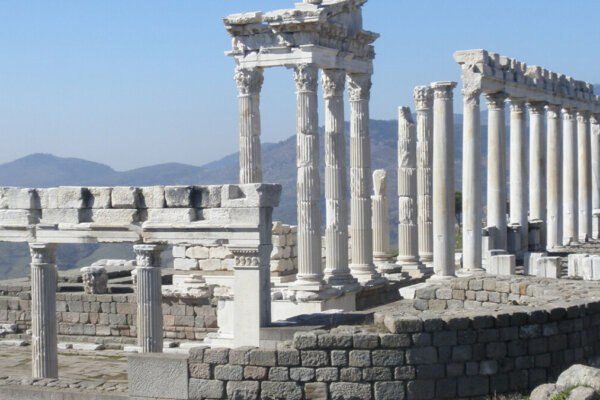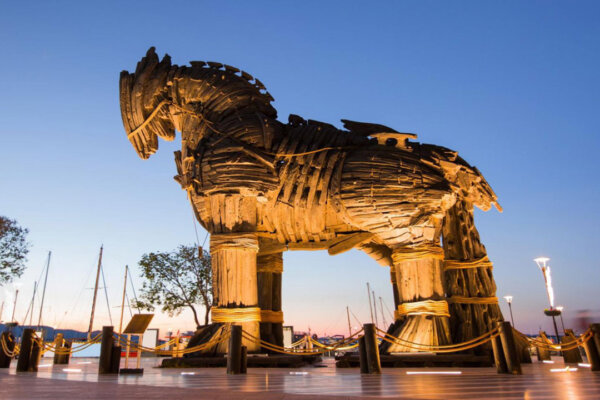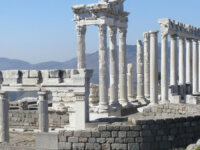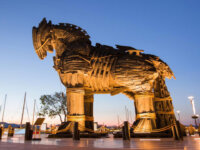TURKEY – The Topkapı Palace was built in the 15th century under the rule of Sultan Mehmed II. It quickly became the center of power for the Ottoman Empire, showcasing both cultural and administrative significance.
Originally known as the New Palace, it was later renamed Topkapı, meaning “Cannon Gate Palace”. This grand royal residence played a pivotal role as the heart of the Ottoman Empire until the 19th century.
Adorned with magnificent paintings, precious decorations, and luxurious courtyards, the Topkapı Palace is a testament to the splendor of the Turkish monarchy. Its opulent harem, rich history, and political intrigue add another layer to the story of this great empire.
Beyond its role as a residence, the palace has transformed into a museum since the fall of the Ottoman Empire in 1923. It now houses a treasure trove of Ottoman history, preserving its legacy for future generations.
Quick information
The Topkapı Sarayi, also known as the Topkapı Palace, is a magnificent historical site located in Cankurtaran, Istanbul, Turkey. This grand palace was built in 1465 and covers an impressive area of over 700,000 square meters. Its architectural style is a blend of Ottoman and Baroque influences, making it a unique and visually stunning structure.
In 1985, the Topkapı Sarayi was recognized as a World Heritage Site by UNESCO, solidifying its significance and value to the world. This recognition is well-deserved, as the palace holds a rich history and cultural significance that has been preserved for centuries.
Every year, the Topkapı Sarayi attracts over 3 million visitors from all around the globe. Its intricate design, opulent interiors, and breathtaking views of the Bosphorus Strait make it a must-visit destination for tourists. The palace also houses a vast collection of artifacts, including precious jewels, weapons, and manuscripts, giving visitors a glimpse into the lavish lifestyle of the Ottoman sultans who once resided there.
Aside from its architectural and historical significance, the Topkapı Sarayi also holds religious importance as it was once the center of the Ottoman Empire’s administration and served as the residence of the sultans and their families. It is also believed to house important relics of Islamic prophets, making it a sacred place for Muslims.
Visiting the Topkapı Sarayi is like stepping back in time and immersing oneself in the grandeur and luxury of the Ottoman era. Its beauty and cultural significance continue to attract millions of visitors each year, making it a must-see destination for anyone traveling to Istanbul.
Time Travel Journey: A Summary of History
Sultan Mehmed II, after conquering Constantinople in 1453, initiated the construction of the New Palace, later known as Topkapı Palace, which was completed in 1465. The damage caused by the earthquake in 1509 prompted significant renovations and improvements to the palace.
Under the reign of Suleiman I, the second gate was completed in 1529, adding to the grandeur of the palace. A devastating fire in 1665 led to extensive renovations and reconstruction.
By 1853, the palace had transitioned from being the residence of the royal family to a place for high-ranking officials. In 1924, Topkapı Palace underwent its final transformation into a museum, housing centuries-old Ottoman heritage. Today, it welcomes over 3 million visitors annually.
The construction of Topkapı Palace was a monumental undertaking, with its location on a hill overlooking the Bosphorus Strait and the Golden Horn making it an ideal spot for a royal residence. The palace complex covers an area of approximately 700,000 square meters and is divided into four main courtyards, each serving a different purpose.
The first courtyard, also known as the Court of the Janissaries, was where the elite soldiers of the Ottoman Empire were stationed. The second courtyard, or the Court of the Divan, was where the sultan would hold meetings with his advisors and conduct state affairs. The third courtyard, called the Court of the Treasury, housed the imperial treasury and other administrative buildings. Finally, the fourth courtyard, known as the Harem, was the private living quarters of the sultan and his family.
Topkapı Palace is not only known for its impressive architecture and design, but also for the valuable artifacts and treasures it holds. The palace museum boasts a vast collection of Islamic calligraphy, manuscripts, ceramics, and jewelry, among other items. One of the most famous pieces on display is the Topkapı Dagger, adorned with emeralds, rubies, and diamonds.
Visitors to Topkapı Palace can also explore the palace kitchens, which were known for their elaborate feasts and banquets during the Ottoman era. The palace gardens, with their beautiful fountains and pavilions, offer a tranquil escape from the bustling city.
In addition to its historical and cultural significance, Topkapı Palace also offers stunning views of Istanbul and its surrounding areas. It is truly a must-visit destination for anyone interested in the rich history and heritage of the Ottoman Empire.
Who built the Topkapı Palace?
Sultan Mehmed II, also known as Mehmed the Conqueror, was a powerful Ottoman ruler who is remembered for his successful conquest of Constantinople in 1453. After this monumental victory, he turned his attention towards rebuilding and revitalizing the city. In 1459, he began construction on various projects to improve the infrastructure and appearance of Constantinople, which had been severely damaged during the siege.
https://www.instagram.com/p/C0o0T4MotEJ/
One of the most significant projects undertaken by Sultan Mehmed II was the construction of the Topkapı Palace, which would serve as the new residence for the sultan and his court. This palace complex was built on the site of the ancient acropolis of Byzantium and was designed to showcase the grandeur and power of the Ottoman Empire. It featured lavish gardens, courtyards, and opulent living quarters for the sultan and his family.
In addition to the Topkapı Palace, Sultan Mehmed II also commissioned the building of several mosques, including the Fatih Mosque, named after the sultan himself. These mosques were not only places of worship but also served as symbols of the Islamic faith and the dominance of the Ottoman Empire. The mosques were adorned with intricate designs and beautiful calligraphy, showcasing the artistic and architectural achievements of the Ottoman civilization.
Furthermore, Sultan Mehmed II also oversaw the reconstruction of the city’s walls and fortifications, which had been crucial in defending Constantinople during the siege. He strengthened and expanded the walls, making them even more impenetrable and adding new towers and gates. This not only provided better protection for the city but also served as a reminder of the Ottoman victory over the Byzantine Empire.
The rebuilding efforts of Sultan Mehmed II were not limited to just the physical structures of Constantinople. He also focused on reviving the city’s economy and culture, encouraging trade and commerce, and supporting the arts and sciences. Under his rule, Constantinople became a thriving center of trade and learning, attracting people from all over the world.
In conclusion, Sultan Mehmed II’s construction projects in Constantinople were not just about rebuilding a city but also about establishing the Ottoman Empire as a dominant force in the region. His vision and determination to revitalize Constantinople left a lasting impact on the city and its people, shaping its history for centuries to come.
Architectural Style: The Fusion of Elegance.
Originally built in the Ottoman style, Topkapı Palace has evolved over the years, incorporating elements of Baroque design in the 18th and 19th centuries.
Its vast complex proudly boasts a harmonious blend of influences from the Ottomans, Persians, Muslims, and Europe, characterized by intricately decorated domes, pointed arches, exquisite marble, and elegant courtyards.
Notable features of its structure: Symmetry and Sophistication
- Royal Council Chamber: Showcases exquisite Iznik tiles.
- Harem: A labyrinth of luxurious rooms.
- Second Gate: Completed under the reign of Suleyman I, a testament to the greatness of the Ottoman Empire.
https://www.instagram.com/p/Cy6lmnqolR7/
Topkapı Palace is a living testament to the grandeur of the Ottomans, where each dome, arch, and courtyard tells a story of the empire’s magnificence and enduring cultural heritage.
Topkapı Palace Collection: The Treasure of Ottoman Greatness.
Topkapı Palace Treasury.
The Royal Treasury of Topkapı Palace, where some of the most coveted possessions of the Ottoman rulers were kept, is a treasure trove of countless masterpieces of art, jewelry, weapons, and more.
Among its precious treasures, it boasts Mustafa III’s armor, the stunning jeweled gold dagger known as the Topkapı Dagger, and the remarkable Spoonmakers Diamond – a breathtaking gem that stands out among the many valuable collections.
https://www.instagram.com/p/C0nsVlQtjp2/
The Topkapı Palace was not only the residence of the sultans but also served as a symbol of their wealth and power. The Royal Treasury, located within the palace, was a highly guarded area where only a select few were granted access. It was here that the most prized possessions of the Ottoman dynasty were stored, showcasing their opulence and grandeur.
The collection housed in the Royal Treasury includes an impressive array of artifacts from different eras, reflecting the diverse cultural influences that shaped the Ottoman Empire. From intricately designed swords and shields to exquisite jewelry adorned with precious gems, each item holds a significant historical and artistic value.
One of the most famous pieces in the collection is the Topkapı Dagger, which is believed to have been made for Sultan Mahmud I in the 18th century. This magnificent weapon is encrusted with emeralds, rubies, and diamonds, making it a true masterpiece of craftsmanship.
Another notable item is the Spoonmakers Diamond, a large pear-shaped diamond weighing over 86 carats. Its name comes from the legend that it was found by a poor fisherman who traded it for three wooden spoons. This diamond has passed through the hands of many rulers and is now one of the most valuable gems in the world.
The Royal Treasury of Topkapı Palace is not just a display of wealth and luxury, but it also offers a glimpse into the rich history and culture of the Ottoman Empire. Its vast collection of treasures continues to fascinate and awe visitors from all over the world, making it a must-see destination for anyone interested in history and art.
Weapon stockpile
The Ottoman Empire’s weapons collection, dating back to the 7th century, is a remarkable display of their military prowess and cultural heritage. This special collection not only features weapons crafted by Ottoman artisans, but also includes items acquired from distant lands.
Among the 400 preserved weapons are swords from the Umayyad and Abbasid eras, as well as armor and helmets from Persia, showcasing the diverse martial arts legacy of the Ottomans. The collection serves as a testament to the empire’s expansion and influence, as they were able to acquire weapons from various regions through trade and conquest.
The craftsmanship of the Ottoman weapons is truly impressive, with intricate designs and engravings that reflect the artistic and cultural influences of the empire. These weapons were not just tools for war, but also symbols of power and prestige for the Ottoman rulers.
In addition to showcasing the military might of the Ottomans, the weapons collection also sheds light on the technological advancements of the empire. From traditional weapons such as swords and spears to more advanced firearms, the collection demonstrates the evolution of warfare during the Ottoman era.
Overall, the Ottoman weapons collection is a fascinating glimpse into the history and culture of one of the most powerful empires in the world. It serves as a reminder of their legacy and impact, both in terms of military conquests and cultural exchange.
European Union.
A significant portion of the ceramic artifacts found in Topkapı Palace have their origins in Europe. These porcelain items were often used as diplomatic gifts between royal families and high-ranking officials.
While the Ottomans initially favored Chinese porcelain, European ceramics gained popularity when their patrons began to support them. The palace boasts an impressive collection of 5,000 European porcelain pieces.
https://www.instagram.com/p/Cz8huwnI4ps/
The exchange of porcelain between Europe and the Ottoman Empire was not only a display of wealth and power, but also a means of cultural exchange. The intricate designs and techniques of European porcelain were greatly admired by the Ottomans, who incorporated them into their own artistic traditions.
The European porcelain found in Topkapı Palace ranges from delicate tea sets to ornate vases and plates. Many of these items were commissioned specifically for the palace, showcasing the close relationship between the Ottomans and their European counterparts.
Aside from their aesthetic value, these porcelain pieces also serve as a testament to the political and economic ties between Europe and the Ottoman Empire. They represent a shared history and a mutual appreciation for the artistry and craftsmanship of porcelain.
Topkapı Palace Library.
With over 20,000 manuscripts, the Topkapı Palace Library is considered a rich historical treasure trove with a close connection to the region. It houses some of the rarest historical and literary works, including examples of calligraphy, thousands of copies of the Quran, and more.
https://www.instagram.com/p/C0ndDRKo10y/
The library’s collection offers a glimpse into the cultural and intellectual heritage of the area, showcasing its diverse influences and contributions to the world. From religious texts to scientific treatises, the manuscripts in the Topkapı Palace Library provide valuable insights into the past and serve as a testament to the enduring legacy of the region.
In addition to its vast collection, the library itself is a work of art, with stunning architecture and intricate designs that reflect the grandeur and opulence of the Ottoman Empire.
Visitors to the library can immerse themselves in the rich history and culture of the region and gain a deeper understanding of its significance in the world.
Inside Topkapı Palace: Exploring What’s Inside.
First field.
The largest and first courtyard in the Topkapı Palace, known as the First Court, boasts impressive architectural wonders such as the Royal Mint and the Byzantine Church of Hagia Irene. As you enter through the grand gate from the first courtyard to the second, you can’t help but be struck by the magnificent blend of influences from the Byzantine era.
The First Court is a testament to the opulence and grandeur of the Ottoman Empire, with its sprawling size and intricate details. It served as the main entrance to the palace and was often used for official ceremonies and events. The Royal Mint, located within the First Court, was responsible for producing the empire’s currency and was considered a symbol of the Sultan’s wealth and power.
But perhaps the most striking feature of the First Court is the Hagia Irene Church, which stands as one of the few remaining examples of Byzantine architecture in Istanbul. Originally built in the 4th century, it was later converted into an armory during the Ottoman period. However, its stunning exterior and interior design still reflect the best of Byzantine art and architecture.
As you walk through the First Court, you can’t help but feel transported back in time to the height of the Byzantine and Ottoman empires. The intricate details and grand structures are a testament to the rich history and cultural influences that have shaped Istanbul into the vibrant city it is today. So make sure to take your time exploring this magnificent courtyard and soak in all its splendor.
Second field.
The second courtyard is undoubtedly one of the most significant areas within the Topkapı Palace. It encompasses the Royal Treasury, the Imperial Council Chamber, and the Gate of Felicity, all of which serve as a testament to the grandeur of Ottoman lifestyle and heritage.
Visitors can also catch a glimpse of the towering walls of the palace kitchen, an architectural masterpiece that holds great historical significance. This kitchen was not only a place for preparing meals for the royal family but also a symbol of the opulence and extravagance of the Ottoman Empire.
As you wander through the second courtyard, you will be transported back in time to the glorious days of the Ottoman era. The intricate details and designs of the buildings and structures are a true reflection of the rich cultural heritage of this magnificent empire.
The Royal Treasury, located within the second courtyard, is a must-see for any visitor to the Topkapı Palace. It houses an impressive collection of precious jewels, gold and silver artifacts, and other valuable items that once belonged to the sultans and their families. This treasury is a true representation of the wealth and power of the Ottoman rulers.
Another notable feature of the second courtyard is the Imperial Council Chamber, where important political decisions were made during the Ottoman period. This chamber is adorned with beautiful frescoes and intricate decorations, showcasing the artistic skills of the Ottoman craftsmen.
Finally, the Gate of Felicity stands tall at the end of the second courtyard, serving as the entrance to the third courtyard. This gate was the official entrance for the sultan and his entourage, and it was here that the sultan would receive foreign ambassadors and dignitaries.
In conclusion, the second courtyard of the Topkapı Palace is a treasure trove of history, culture, and architectural marvels. It is a must-visit for anyone seeking to immerse themselves in the grandeur and splendor of the Ottoman Empire.
Third field.
The third courtyard, which is less crowded than the others, welcomes Agas, individuals who have been trained in various forms of art and reside within the area. It boasts a grand audience hall, where the king sits upon a high throne to address his subjects.
This section of the palace also includes libraries, Agas’ mosques, and small exhibition rooms that showcase the beauty of the courtyard. These spaces serve as a testament to the rich cultural heritage and artistic talents of the people living within the palace walls.
The libraries house a vast collection of literature, ranging from ancient manuscripts to modern works, providing a glimpse into the intellectual pursuits of the residents. The mosques, with their intricate designs and stunning architecture, offer a peaceful sanctuary for prayer and reflection.
In addition, the small exhibition rooms display a variety of artwork, including paintings, sculptures, and handicrafts, all created by the skilled hands of Agas. These displays not only add to the aesthetic appeal of the courtyard but also serve as a platform for showcasing the diverse talents of its inhabitants.
Overall, the third courtyard serves as a hub of creativity and cultural exchange, where Agas can express themselves through various forms of art and share their traditions with others. It is a true reflection of the vibrant and dynamic community that resides within the palace grounds.
The royal harem of Topkapı Palace.
With over 400 rooms, the Harem of Topkapı Palace is one of the most private areas of the royal residence. It includes the Queen’s Courtyard, the luxurious baths of the King and Queen, as well as the private chambers of many princes.
This complex is one of the most intricate and exquisitely crafted parts of the palace. It was designed to be a secluded and exclusive space for the royal family, away from the public eye. The word “harem” itself comes from the Arabic word “haram,” meaning sacred or forbidden, highlighting the exclusive nature of this area.
The Harem was not only a place for the royal family to reside, but it also served as a center for political power and intrigue. Many important decisions were made within its walls, and it was said that whoever controlled the Harem, controlled the empire.
https://www.instagram.com/p/C0qOgjDNsmk/
The layout of the Harem is a maze of interconnected rooms and courtyards, creating a sense of mystery and privacy. Its architecture is a blend of Ottoman, Persian, and Byzantine styles, reflecting the diverse cultural influences of the time.
One of the most famous features of the Harem is the Queen’s Bath, a stunning example of Ottoman architecture with its intricately decorated marble walls and domed ceiling. This bath was reserved exclusively for the use of the Queen and her female attendants.
The Harem also housed the private quarters of the Sultan, his wives, and concubines. These rooms were lavishly decorated with exquisite carpets, silk fabrics, and precious jewels, showcasing the wealth and power of the Ottoman Empire.
Today, visitors can explore the Harem and get a glimpse into the opulent lifestyle of the Ottoman rulers. It is a fascinating and must-see part of Topkapı Palace, offering a unique insight into the history and culture of Istanbul.
Topkapı Palace – A World Heritage Site recognized by UNESCO.
The significance of Topkapı Palace, with a history spanning over 400 years as the capital of the Ottoman Empire and the seat of Ottoman power, has earned it recognition as a UNESCO World Heritage Site in 1985.
Even after its conversion into a museum in 1924, the artifacts and architectural structures within the palace continue to serve as precious pieces of medieval history, contributing to the esteemed status of the palace on the global stage. The palace complex is a testament to the grandeur and opulence of the Ottoman Empire, showcasing its rich cultural heritage and influence on the world.
Originally built in the 15th century by Sultan Mehmed II, Topkapı Palace served as the primary residence and administrative center for the Ottoman sultans for centuries. It was not only a symbol of power and authority but also a hub of artistic and intellectual activities, attracting scholars, artists, and dignitaries from all over the world.
The palace is divided into four main courtyards, each containing various buildings and gardens that showcase different aspects of Ottoman life and culture. The Imperial Treasury, Harem, and the Sacred Relics Chamber are among the most popular attractions within the palace, housing priceless treasures such as jewels, manuscripts, and religious relics.
Aside from its historical and cultural significance, Topkapı Palace also boasts stunning architecture, blending elements of Byzantine, Islamic, and Ottoman styles. Its intricate designs, colorful tiles, and ornate details are a reflection of the empire’s wealth and sophistication.
Today, Topkapı Palace remains a must-visit destination for tourists and history enthusiasts alike, offering a glimpse into the glorious past of the Ottoman Empire and its lasting impact on the world. Its inclusion in the list of UNESCO World Heritage Sites is a testament to its enduring legacy and importance in preserving our global heritage.
FAQs about Topkapı Palace
What is the best time to visit Topkapi Palace?
The best time to visit Topkapi Palace is during the spring (April-May) or autumn (September-October) when the weather is pleasant and there are fewer crowds. The palace can get very crowded during the summer months, so it is recommended to visit early in the morning or late in the afternoon.
How much time should I allocate for a visit to Topkapi Palace?
It is recommended to allocate at least 2-3 hours for a visit to Topkapi Palace to fully explore all its courtyards, buildings, and exhibits. However, if you want to take your time and fully immerse yourself in the experience, you may need more time.
Are there any restrictions for visiting the Harem?
Yes, there is an additional entrance fee to visit the Harem, and visitors are required to join a guided tour. This is to ensure the preservation of the delicate artifacts and structures within the Harem.
Can I take photos inside Topkapi Palace?
Yes, photography is allowed inside the palace, except for certain areas such as the Harem and the Sacred Relics Chamber. However, the use of flash and tripods is not permitted.
Is there a dress code for visiting Topkapi Palace?
There is no specific dress code, but it is recommended to dress modestly out of respect for the cultural and religious significance of the palace. It is also advisable to wear comfortable shoes as there is a lot of walking involved.
Conclusion
In conclusion, Topkapı Palace is a magnificent and historically significant landmark that offers a unique insight into the grandeur and opulence of the Ottoman Empire. Its stunning architecture, rich cultural heritage, and prestigious status as a UNESCO World Heritage Site make it a must-visit destination for anyone interested in history, art, and culture. From the grand audience hall to the private chambers of the royal family, every corner of Topkapı Palace tells a story and adds to its charm and allure. It is truly a gem of Istanbul and a testament to the enduring legacy of the Ottoman Empire.



















